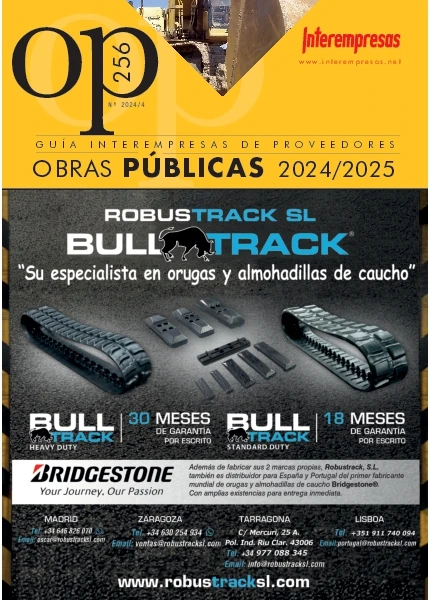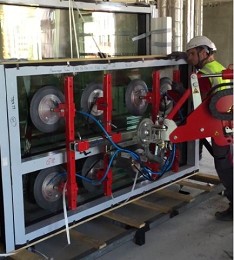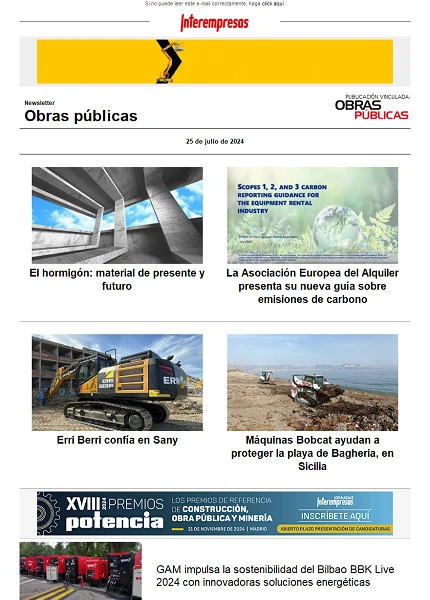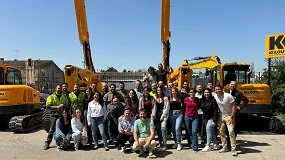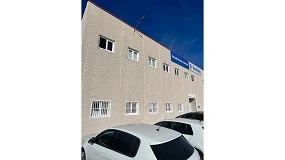The road network, engaged by the reduction of the investment in maintenance
According to the audits realizar by the
The current state of conservation of the Spanish roads situates this subject to the tail of the political worries, as it gives off of the results obtained in the ‘Study on Needs of Investment in Conservation' developed by the Spanish Association of the Road (AEC) in the second semester of 2013.

National road: cracks in the paving and marks viales worn.
Treats of an investigation that has his origin in the Campaigns of Visual Inspection of the Road Network that the AEC began to realizar in 1985 with the aim to know the state of the paving and of the equipment, as well as to determine the necessary minimum investment to reach levels of suitable service.
In general terms and in accordance with the conclusions of the study, at present the Spanish roads find in a state of conservation 'deficient', brushing already the 'very deficient'. Give him the turn to this situation requires a minimum investment of 6.200 million euros, quantity in which the AEC enciphers the deficit that accumulates the maintenance of the group of the road infrastructures of the country.
A deficit that between 2011 and 2013 has increased near of 13% (20% in the network that manages the State and 10% in which they administer the autonomic governments).
In definite, the Spanish roads confront to an unprecedented deterioration, while the audits of the AEC shows the worst situation of all the series of the study, that starts in the year 1985.
The consequences: deterioration of the comfort of the circulation and of the hygiene vial; loss of competitiveness interterritorial and regarding our European partners; exponential increase of the costs of repair (each no invested euro to time in reinforcement of firm transforms in 5 € to the three years and in 25 € in the fifth); increase of the costs of maintenance of the vehicles and increase of the broadcasts contaminantes, etc.
The state of the pavings accumulates 94% of the total deficit
The most stood out conclusion of the ‘Study on Needs of Investment in Conservation' is, definitely, the remarkable and accelerated deterioration of the pavings so much in the Network of Roads of the State as in the Autonomic Network, obtaining a half qualification of 'deficient' in both cases, and engaging the resistant capacity of the inferior layers.
No in vain, the paving accumulates 94% of the total deficit in conservation, what translates in some needs of investment in replacement and reinforcement of firm enciphered in 5.828 million euros for the group of the Spanish roads. Of them, the Network of the precise State of 1.883 millions, and the Autonomic Network of 3.945 millions.
In the chart of evolution of the state of the firm, observes how the situation is especially grave for the autonomic roads, that register a fall of 23 points in his half note in comparison with the year 2011. With regard to the firm of the roads of the State, have lost 14 points between 2011 and 2013.

For both networks, the study of the Spanish Association of the Road awards to the state of conservation of the firm the worst note of all the series; so much it is so, in the case of the Network of the State registers a loss of 23 points regarding the first audits, realizar in 1985. By what refers to the autonomic roads, the paving obtains 25 points less than 30 years ago.
In effect, at present three of each four kilometres of paving presents cracks in the filmed (72% of the network) and one of each three shows cracks, disintegrations, deformations and potholes (38%).
Already in the regional field, the investigation of the Spanish Association of the Road only awards a ‘approved' to the roads that cross Extremadura and the Basque Country. With a qualification of ‘very deficient' appear the roads that discurren by The Rioja, followed very closely of the ones of Aragon.
Vertical signaling: It Is necessary to replace 330.000 signals
With a half qualification of 4,6 and 4,1 respectively, the vertical signaling in the roads of the State and in the Autonomic obtains a punctuation underneath of the approved. With this consolidates the qualification of ‘deficient' that this type of signaling comes dragging from the first years of the decade of 2000.
In the state network, around 83.000 signals surpass the age of seven years (period of guarantee awarded by the manufacturers for the plates retrorreflectantes), what translates in that, although during the day the signal shows in a state of conservation adapted, at night his visibility is not guaranteeed, when having caducado the material retrorreflectante.
In the Autonomic Network, by his part, would be necessary to renew some 247.000 signals, what represents an investment of 52 million € (27 millions for the roads of the State).
In this point, the Spanish Association of the Road remembers that these data obey to a visual observation of the deteriorations that present the signals. If it resorts to an analysis by means of mechanical procedures, the panorama shows even more black. So much it is so in 2013 it has carried out an inspection by means of retrorreflectómetro portable, whose conclusions are demoledoras: in one of each two signals —caducadas and no caducadas—, the material retrorreflectante has lost the condition of such.
In when to the territorial indicator, so only the signaling of code of the roads of Catalonia achieves to escape to the suspense.
Horizontal signaling: it Is necessary repintar the marks viales of 52.000 kilometres of road
In the case of the Network of the State, the stability that revealed the results obtained in the ‘Study on Needs of Investment in Conservation' of the year 2011 for the marks viales, with indexes inside the approved high, breaks in the report of 2013. The horizontal signaling loses three points in his levels of conservation, although, this yes, keeping in the half qualification of ‘acceptable'.
The mesh to charge of the Autonomous Communities stabilises in the ‘deficient ‘', with a similar punctuation to the one of the edition precedent of this study: 4,9.
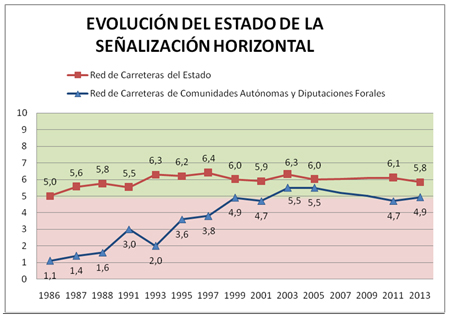
According to this report, would have to repintarse the marks viales of 28 of each 100 kilometres of roads in the state network, and of 49 of each 100 kilometres in the Autonomic, what requires a global investment of 103 million € (14 and 89 millions in each one of the respective networks).
By regions, the good notes of Galicia, the Valencian Community and Catalonia contrast with the ones of Murcia, Castile-La Mancha, Andalucia and Extremadura, the only that suspend in this chapter.
The metallic barriers go back to the suspense
Regarding the metallic barriers —and splitting of the fact that the AEC only studies the installed barrier and no the need of his installation in those stretches that lack the same—, the study of the Association suspends them, ascertaining a clear impairment so much in the state roads (with qualifications that have happened of 5,6 in 2011 to 4,7 in 2013) as in the autonomic (of 5,2 to 4,6).
In accordance with the data of the Spanish Association of the Road, 189 million € of investment would contribute to improve this element. A figure that distributes in 70 millions for the barriers of the Network of the State, and 119 millions for the installed in the Network of the Autonomous Communities.
Call the attention, in the comparative by regions, the suspenses of Murcia and Andalucia. The another expensive of the coin configure it Extremadura, the Valencian Community, Galicia, Aragon, Castile and Leon, Catalonia and Castile-La Mancha.
Also the balizamiento deteriorates : of a ‘very' low to a ‘acceptable ‘'
Of all the elements analysed, has been traditionally the balizamiento the one who has presented a healthier state in both networks. But those notes that rondaban the 8 in previous years disappear in the campaign of 2013, giving step to qualifications more modest.
In the regional analysis, stand out six communities above the average, situated in the 5,9, and nueve underneath, in some cases with a suspense.
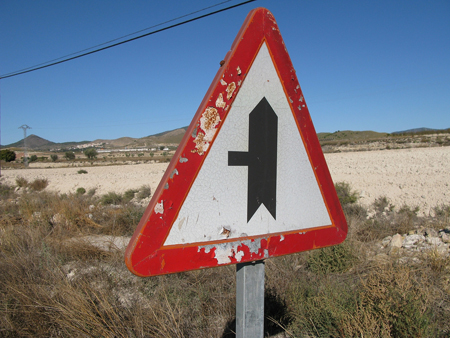
Lighting: 82% of the luminarias in operation register unsuitable ranks of iluminancia, almost 40% more than in 2012
This is the worrisome data that launches the investigation of the AEC in his analysis of the state of this type of equipment, indispensable for the hygiene vial during the nocturnal circulation.
The study auditss the half parameters of iluminancia (quantity of light that arrives to the paving) and uniformity (homogeneity of said light), concluding that 82% of the luminarias, in the first case, and 40% in the second, register ranks no suitable.
Of 82% of the luminarias that register unsuitable ranks of iluminancia, 16% are it by excess (affecting to the energetic efficiency) and 66% by defect (repercutiendo in the hygiene of the traffic).
The fault of uniformity in the lighting also increases the exhibition to the risk, since they generate zones of darkness between areas lit (claroscuros); this defect detects in 40% of the luminarias in operation.
In the inspection realizar in 2012, the percentages of iluminancia and wrong uniformity concerning the total of luminarias in operation situated in 59% and 24% respectively.
Needs of investment: 6.200 million €
Regarding the needs of investment of the roads in service, the figures shoot . To achieve some sufficient levels in the two networks studied would be necessary an investment of 6.200 million €, that is to say, 13% more than in 2011. The quantities deliver according to the following table:
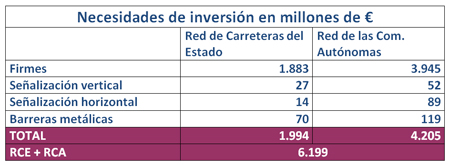
By kilometre of road, between 2001 and 2013 the needs of investment have grown 111% in the network that depends of the State, and 102% in the roads that manage the Autonomous Communities.
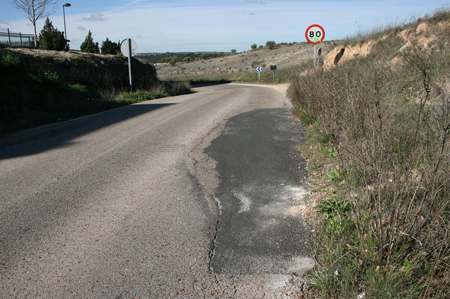
Work of field
The work of field of the ‘Study on Needs of Investment in Conservation' has been developed in the months of July to September of 2013 by ten evaluadores, which visited the stretches that were them assigned and reflected his observations in the leaves of taking of data prepared to the effect.
In total have evaluated 3.000 stretches, of 100 metres each one, so much in the Network of Roads of the State as in the dependent Network of the Autonomous Communities and Deputations Forales.
The Indexes of State reveal, by comparison with a series of values given the state of conservation of the road infrastructures. Such Indexes consist in a note ponderada obtained from the deteriorations considered in each stretch, offering in the cases of the vertical signaling, horizontal, metallic barriers and balizamiento, a figure between 0 and 10 in accordance with the greater presence or absence of defects (10 = very good state).
Regarding the firm, the values used for the establishment of the degree of deterioration situate in an interval of 0 to 400, represented the 400 the best possible situation.
Only evaluate stretches of roads interurbanos, chosen randomly. They do not analyse motorways of toll. It treats of a visual inspection, that is to say, so only study the deteriorations that observe to simple sight (the report does not consider, for example, problems that go further of the layer of rolling of the firm, operations of conservation in works of drainage or in works of factory, etc.).



